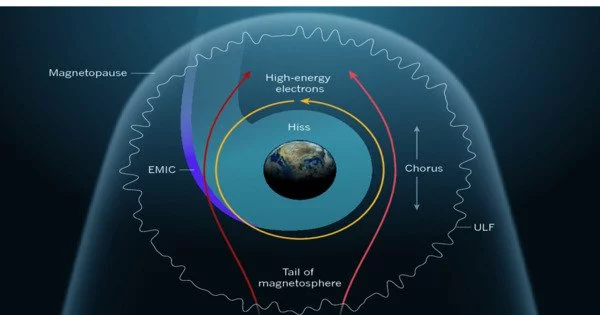Waves in plasmas are electromagnetic waves that travel through an ionized gas containing charged particles such as electrons and ions. Plasmas can be found in a variety of natural and artificial environments, including stars, lightning, fusion reactors, and semiconductor manufacturing.
Waves in plasmas are an interconnected set of particles and fields that propagate in a periodically repeating fashion in plasma physics. A plasma is an electrically conductive, quasineutral fluid. It is composed of electrons and a single species of positive ions in the simplest case, but it may also contain multiple ion species, including negative ions and neutral particles. A plasma couples to electric and magnetic fields due to its electrical conductivity. This complex of particles and fields is capable of supporting a wide range of wave phenomena.
Electromagnetic waves, electrostatic waves, and magnetohydrodynamic (MHD) waves are all examples of waves that can propagate through plasmas. The frequency, wavelength, polarization, and dispersion of these waves can all vary.
The plasma oscillation, which is a collective oscillation of charged particles in a plasma, is an important type of plasma wave. Plasma oscillations can occur in both collisionless and collisional plasmas, and they are crucial for understanding plasma behavior in a variety of applications, including plasma processing and fusion. The Alfvén wave, a type of MHD wave that propagates along magnetic field lines, is another important type of plasma wave. Understanding plasma behavior in astrophysical environments such as the solar wind and magnetospheres requires an understanding of Alfvén waves.
There are several types of waves that can propagate in plasmas, depending on the properties of the plasma and the frequency of the wave. Some common examples include:
- Electrostatic Waves: These are waves that involve only the electric field and occur in plasmas where the ions are immobile. They can be longitudinal or transverse in nature, depending on the direction of the wave propagation relative to the electric field.
- Electromagnetic Waves: These are waves that involve both electric and magnetic fields and can propagate through any type of plasma. Examples include radio waves, microwaves, and light.
- Alfven Waves: These are waves that involve both magnetic fields and the motion of charged particles along the magnetic field lines. They can propagate through plasmas that have a strong magnetic field.
- Langmuir Waves: These are waves that involve the collective oscillations of electrons in a plasma. They are typically excited by a beam of electrons and can propagate through plasmas with a high electron density.
- Plasma Waves: These are waves that involve the motion of both ions and electrons in a plasma. They can be excited by external sources, such as radio waves or lasers, or can arise spontaneously due to the thermal motion of the particles in the plasma.
Understanding plasma waves is important for many fields, including plasma physics, astrophysics, and space science. The study of plasma waves is also important for developing new technologies based on plasma, such as plasma thrusters and plasma processing techniques.
















